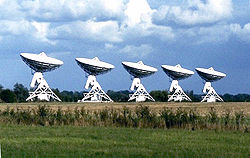
Ryle Telescope
Encyclopedia

Radio telescope
A radio telescope is a form of directional radio antenna used in radio astronomy. The same types of antennas are also used in tracking and collecting data from satellites and space probes...
array at the Mullard Radio Astronomy Observatory
Mullard Radio Astronomy Observatory
Mullard Radio Astronomy Observatory is home to a number of large aperture synthesis radio telescopes, including the One-Mile Telescope, 5-km Ryle Telescope, and the Arcminute Microkelvin Imager...
. In 2004 three of the telescopes were moved to create a compact two-dimensional array of telescopes at the east end of the interferometer
Interferometry
Interferometry refers to a family of techniques in which electromagnetic waves are superimposed in order to extract information about the waves. An instrument used to interfere waves is called an interferometer. Interferometry is an important investigative technique in the fields of astronomy,...
. The remaining five antennas were switched off on 19 June 2006. The eight antennas have now become the Arcminute Microkelvin Imager
Arcminute Microkelvin Imager
The Arcminute Microkelvin Imager consists of a pair of interferometric radio telescopes - the Small and Large Arrays - located at the Mullard Radio Astronomy Observatory near Cambridge. AMI was designed, built and is operated by the Cavendish Astrophysics Group...
Large Array.
The Ryle Telescope was an eight-element interferometer operating at 15 GHz (2cm wavelength)
Ku band
The Kμ band is a portion of the electromagnetic spectrum in the microwave range of frequencies. This symbol refers to —in other words, the band directly below the K-band...
. The elements were equatorially mounted 13-m Cassegrain
Cassegrain reflector
The Cassegrain reflector is a combination of a primary concave mirror and a secondary convex mirror, often used in optical telescopes and radio antennas....
antennas, on an (almost) east-west baseline. Four aerials were mounted on a 1.2 km rail track, and the others were fixed at 1.2 km intervals. Baselines between 18 m and 4.8 km were therefore available, in a variety of configurations. For high-resolution imaging, the mobile aerials were arranged along the track, to give uniform baseline coverage to 4.8 km; for low-brightness astronomy (e.g. the Sunyaev-Zel'dovich effect
Sunyaev-Zel'dovich effect
The Sunyaev–Zel'dovich effect is the result of high energy electrons distorting the cosmic microwave background radiation through inverse Compton scattering, in which the low energy CMB photons receive energy boost during collision with the high energy cluster electrons...
) the mobile aerials were arranged in a 'compact array', with a maximum baseline of about 100 m. All antenna pairs were correlated, so some long baseline data were always available, even in the 'compact array' configuration.
As the telescope was an east-west instrument, most imaging observations involved 12-hour observations in order to fill the synthesised aperture
Aperture synthesis
Aperture synthesis or synthesis imaging is a type of interferometry that mixes signals from a collection of telescopes to produce images having the same angular resolution as an instrument the size of the entire collection...
(calibration
Calibration
Calibration is a comparison between measurements – one of known magnitude or correctness made or set with one device and another measurement made in as similar a way as possible with a second device....
observations are routinely interleaved). Another consequence of the geometry was that it is not practical to image sources near the equator
Equator
An equator is the intersection of a sphere's surface with the plane perpendicular to the sphere's axis of rotation and containing the sphere's center of mass....
, or in the south. The two-dimensional Large Array overcomes this problem with its new north-south baselines.
Although the telescope was not designed as a common user instrument, the operators were happy to accept proposals for observing time on the instrument from outside observers, provided that they did not overlap substantially with existing observing programmes, on a 'best efforts' basis. Monitoring variable sources was possible using short observations which could often be inserted between longer 'standard' observations.
The telescope had three main scientific programs: study of the Sunyaev-Zel'dovich effect
Sunyaev-Zel'dovich effect
The Sunyaev–Zel'dovich effect is the result of high energy electrons distorting the cosmic microwave background radiation through inverse Compton scattering, in which the low energy CMB photons receive energy boost during collision with the high energy cluster electrons...
in galaxy clusters
Galaxy groups and clusters
Galaxy groups and clusters are the largest known gravitationally bound objects to have arisen thus far in the process of cosmic structure formation. They form the densest part of the large scale structure of the universe...
, particularly in determining the Hubble constant; surveying for radio sources that would contaminate degree-scale observations
Cosmic microwave background experiments
There have been a variety of experiments to measure the Cosmic microwave background radiation anisotropies and polarization since its first observation in 1964 by Penzias and Wilson. These include a mix of ground-, balloon- and space-based receivers...
of the cosmic microwave background
Cosmic microwave background radiation
In cosmology, cosmic microwave background radiation is thermal radiation filling the observable universe almost uniformly....
made with the Very Small Array
Very Small Array
The Very Small Array is a 14-element interferometric radio telescope operating between 26 and 36 GHz that is used to study the cosmic microwave background radiation. It is a collaboration between the University of Cambridge, University of Manchester and the Instituto de Astrofisica de Canarias...
, and flux monitoring of galactic variable sources.
External links
- Eight Ryle antennas on Google Maps. The three northern antennas can also be seen at their old locations due west, as the latter area has not been remapped.

